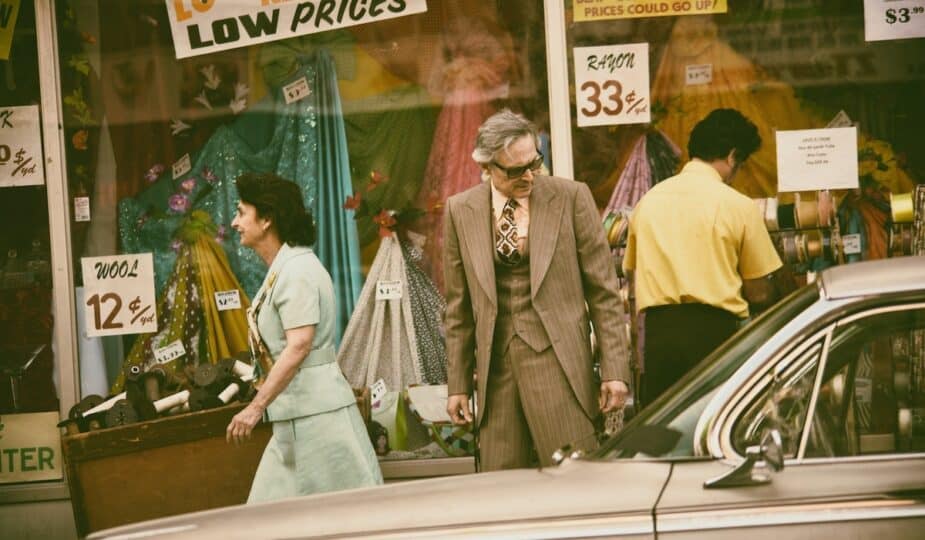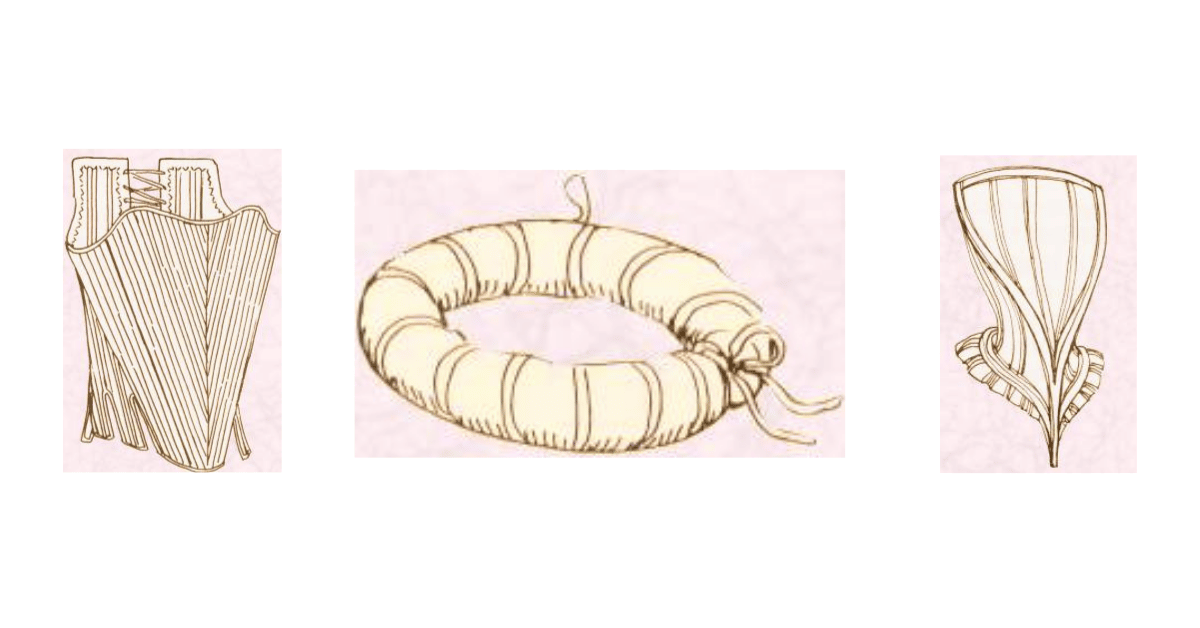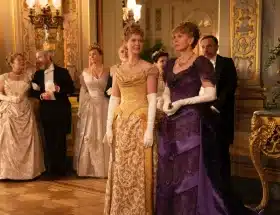- Shopping in the Victorian and Edwardian Eras
- Partially Made Clothes
- The Sewing Machine and Butterick Paper Patterns
- Development of New Department Stores
- Clothing for the Victorian Rich
- Charles Worth - Fashion Designer
- Selfridges Department Store in London Founded in 1909
- Clothing for the Average Person
- Ready Made Clothing was made in Specific Localities:
- Cheap Slop Work Clothes
- The London East End Sweat Shop Tailoring Trade
- Second Hand Clothing Markets For the Poor
- Clothes for an Edwardian Seamstress
- Mass Produced Clothes for all
- Internet Shopping
Shopping in the Victorian and Edwardian Eras
Today ordinary people all over the world obtain clothes from a very wide variety of global sources. We shop from the Internet, from mail order, from TV Channels, from the High Street or nearby outlet mall a few miles away. In the past shopping was more difficult.
It was not until the start of the nineteenth century that a form of mass produced clothing developed. It was of a simple basic style, mainly for ordinary men and women and unsuitable for the high fashion market of the upper classes. It could not compete with high class tailoring and it was not until the 1850s that standards of making began to gradually improve as the century wore on.
The only acceptable ready made items for the wealthy were free size garments like mantles, cloaks and shawls.
Partially Made Clothes
Until the 1850s all sewn clothes were entirely stitched by hand. In Britain partly made clothes were made by London firms and these were sold on to country dressmakers and drapers. The partially completed bodices or partly made clothes were then completed to ensure a good fashion fit. This was usually done by dressmakers or the customer herself.
From early Victorian times this was very common and evolved into the skirt being fully made and the matching bodice fabric being sold for individual styling. Short notice mourning clothes had been sold in this manner since the 1860s and led the way for the concept of ready made women's garments.
You are reading an original 'history of shopping', fashion history article by Pauline Weston Thomas at www.fashion-era.com ©.
The Sewing Machine and Butterick Paper Patterns
Although sewing could be a sweat trade it was also considered a gentle art and a skilled refinement for women. The customer or her maid was often quite experienced at making up garments.
The mid 19th century mass marketing of the domestic sewing machine by Singer successfully introduced the concept of hire purchase. Then the introduction of paper patterns by Butterick and later the McCall's Pattern Company, helped make home dressmaking more successful.
Development of New Department Stores
At the same time the acceptance of better fitting, ready made goods, combined with easier travel for all classes, eventually led to the development of department stores. Later some of these blossomed into the huge department stores like Selfridges.
By the mid Victorian era in the UK Jolly of Bath, Bainbridge's of Newcastle, Kendal Milne of Manchester and Whiteley's were well established in Britain.
In France too large department stores opened mid century. Several shops traded under one roof initially. When these failed, newer ventures of departments, owned by one person were more successful. They helped to create a new middle class type of costume of ready to wear mass produced styles.
Clothing for the Victorian Rich
In the Victorian era rich women of Europe and America still looked to Paris for fashion inspiration. Designers of the period include the Houses of Worth, Redfern, Paquin, Lucile, Fortuny, Doucet, Callot Soeurs, and Poiret.
Charles Worth - Fashion Designer
Charles Worth had become a very successful designer in Paris. He was the first real fashion designer of the system called haute couture in a form we would recognise today. He had an idea to make a collection of clothes in advance and then show them to his clients.
He soon gained royal patronage. By 1870, he employed well over 1000 employees working as seamstresses. It was his designs that promoted the mid Victorian bell sleeve. He was the earliest designer to give two seasonal fashion shows and he started a trend we see today.
As a fashion promotion he dressed prominent clients such as well known actresses, from his own pocket. In turn this attracted wealthy customers to him who acknowledged the women wearing his designs and who were doing some subtle subliminal advertising for him.
The stars today that wear particular outfits at the Oscar ceremonies and the design houses that sponsor them, are behaving in an identical manner. Human nature stays much the same whatever the century.
Self promotion under the guise of promoting another is always popular.
Selfridges Department Store in London Founded in 1909
The wealthy bought their clothes from court dressmakers or large stores such as Harrods or Peter Robinson.
The American, Gordon Selfridge, invested in building a huge store in Oxford Street, London in 1909.
Staff were hired months before it opened. They were trained in selling the Selfridge way.
Shoppers flocked to the store when they heard of the delights inside.
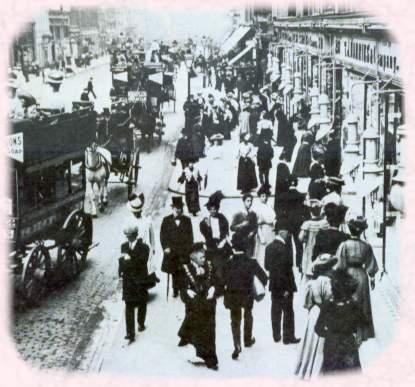
At last they could openly obtain goods such as make up and perfume easily. Clothes departments sold all manner of goods and hard to find items. Music greeted the shoppers and browsing there could be an all day experience.
Shopping there was intended to be a recreation. The store was revamped in 1997 and despite the many years since it opened for shopping, browsing and eating there is still a once in a while all day luxury recreation experience for others too.
Debenham and Freebody also rebuilt their department store on Oxford Street in 1908 and at nearby Regent Street, Liberty flourished, whilst Bond Street developed exclusive small niche shops. As the 20th Century progressed London's West End became one of the busiest areas for shopping in the world.
You are reading an original 'history of shopping', fashion history article by Pauline Weston Thomas at www.fashion-era.com ©.
Clothing for the Average Person
For the average Victorian person shopping for apparel was an expensive matter. Limited outer garments were sold ready made. Instead customers bought the fabric, trimmings, linings and threads to be made up by a tailor or dressmaker. Often the garments were made at home.
So much intensive hand work was involved that finished textile goods were expensive. Shopping for fabric for a garment was a special event for ordinary people. An item would be made with the idea that it was to last, and last it did.
Later it would be cut down for children or adolescents. Sometimes women had the garment restyled or a new bodice added. Versatility was achieved by using detachable trims such as replacing white collars or engageantes (false blouson lower under sleeves) or having converting yoked collars which when removed could transform a dress into a low cut evening gown.
Travelling salesmen called pedlars, Manchester men, Scotchmen, Talleymen or packmen brought materials and haberdashery such as colourful ribbons and hat trims to country areas.
Dress and shirt lengths, remnants of all kinds and material like corduroy for men were all in his pack. On market days these pedlars were known as Manchestermen, Scotchmen or Talleymen.
Ready Made Clothing was made in Specific Localities:-
Felt Hats
Manchester, Stockport
Gloves
Dent Allcroft of Worcester
Hosiery
Morley of Nottingham
Mackintoshes
Macintosh of Manchester
Shoes
Street in Somerset
Fine Silk Goods
Nottingham
Machine Lace
Nottingham
Woollens, Jackets, Shawls, Mittens
Leicester
Cheap Slop Work Clothes
Cheap, "slop work" basic clothes for sailors were made in and around UK ports.
Much of it was intended for export to the colonies and to provide lifetime outfits for emigrants to the USA and other continents. Ready made clothing for the general public was an expansion of this earlier trade. Women's underwear, including crinolines and corsets were made in Bristol and Portsmouth.
In America hardware stores distributed basic work clothes and bolts of fabric. Second hand clothing was also exported across the Atlantic to Canada, unwittingly taking cholera there in the 19th century.
The London East End Sweat Shop Tailoring Trade
Tailored garments were made in the East End of London and at Liverpool. The sweat shop system employed poor immigrants and by 1840 the East End of London was thronged with tailors. Because of the low wages they were able to produce trouser, coat and jacket clothing at very low prices. Many of the East End tailoring trade workers worked at home.
For some men and women that meant doing piece work on the sweating system up to 14 hours a day, and even up to 18 hours in the busy season. Home was a combined workshop, bedroom, living room and kitchen. Those that could afford superior tailoring looked down on those that bought ready made ready ticketed goods.
The reason was simply that the clothes were never a good fit and usually looked as if they had belonged to another person. Even so methods of pattern drafting and sizing for a reasonable average fit were improving and these shops were well received by the average person.
You are reading an original 'history of shopping', fashion history article by Pauline Weston Thomas at www.fashion-era.com ©.
Second Hand Clothing Markets for the Poor
Today we think of a market selling bric-a-brac and other cast off items as a picturesque affair. But the second hand clothes market was an essential service for the poor in society. The nearest we have to this today is the clothing found in charity shops which in the main is not worn out, nor threadbare, but simply not even in style in mass fashion.
This type of clothing cannot be compared to the second hand goods that were more likely to be fifth or fourth hand. Nor can it be likened to Vintage Clothing of today which is frequently very desirable, having been well maintained, worn only occasionally and probably very attractive originally.
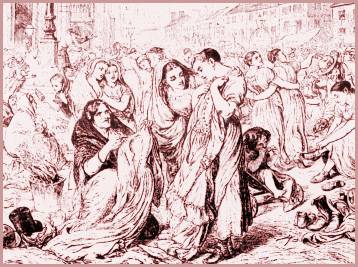
In the 18th and 19th centuries second hand clothing markets existed in every major city of Britain.In London's Petticoat Lane and Rosemary Lane, the best sellers were frock coats and great coats. The market held at Camp Field in Manchester in Northern England sold threadbare garments bought by the very poor and needy.
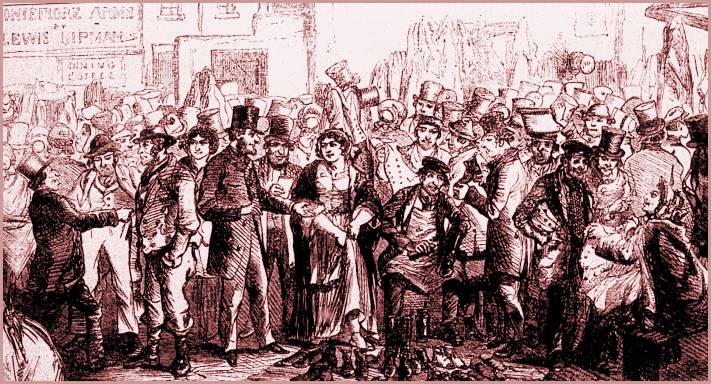
The fact that they were threadbare is a reason why so little working class clothing exists in museums. What we often see entombed in a museum glass display case in excellent condition, is usually the clothing of the well off, or servants of the rich.
Clothes for an Edwardian Seamstress
Like other lower class workers, the London working woman such as a seamstress obtained most of her clothes from one of the second hand markets held in the neighbourhood of Bermondsey New Road in London.
In the book Human Documents Of The Age Of The Forsytes, E. R. Pike tells of:- '... the usual scene of second hand female underclothing, the surrounding crowd consisting of the poorest middle aged women-mothers. It is an almost silent trade, for not a word passes beyond the naming of the price.
The garment is sold or not sold, and if not sold goes back on to the rising heap and another held in view.'
The same women queued to buy boots. It was said that a factory inspector could tell if a worker was paid enough by looking at the state of her boots. Boots that were polished and in good repair were indicative of a fair wage, whilst tattered worn boots were evidence of 'sweated labour'. An observer at the second hand market wrote....
'The boots are a remarkable sight. It takes time to buy boots; you have to try them on; and the customers wait their turns, seated in rows till served. '
Unlike the rich society hostess, who wore fine ribbed silk or cashmere stockings, with her boots, the humble dressmaker had to be satisfied with cotton lisle stockings, perhaps purchased from one of Michael Marks' Penny Bazaars.
It is unlikely that Edwardian seamstresses ever bought completely new major items, such as a coat, but evidence does suggest that a dressmaker would have bought trimmings to brighten up her second hand clothes as well as recutting old clothes to make 'new' garments. She may even have made the odd dress from fabric bought weekly through a clothing club.
You are reading an original 'history of shopping', fashion history article by Pauline Weston Thomas at www.fashion-era.com ©.
Mass Produced Clothes for All
Mass production of clothing was refined in the UK during the 1939-45 war. Strict restrictions ensured that manufacturers produced goods of a high standard under the Utility Scheme. Manufacturers were only given cloth if they produced a percentage of utility clothes.
Only those companies who could achieve high standards stayed in business. This set the tone for superior production of well made clothes after the war.
Recycling of Rags
As late as 1975, it was not uncommon to hear a rag and bone man crying out for old clothes, rags and bones. Now most second hand clothing finds its way directly to charity shops, jumble sales, garage sales, school fairs or car boot sales.
What they cannot sell eventually finds its way to huge reprocessing warehouses in the North of England. There the clothes are sorted into fabric type, then mechanically torn and shredded apart to be recycled as lower grade textile goods, felts, mixed yarns or to be mixed with new fibres to reduce costs.
Online Shopping
You may want to try internet shopping. There are many companies that provide a great service and goods. Take a look at internet shopping systems and browse their stock.
You will find everyday repeat items such as jeans and underwear much easier to buy this way, particularly if you have a repeatable brand item in a size and style you like already in your existing wardrobe.
Footnote:- This page was partially based on content I updated from a dissertation I first wrote in 1979. The dissertation a Comparative Study Between the Rôles of the Edwardian Hostess and the Edwardian Seamstress looked at the symbolism behind Edwardian dress and the rôles of women in Edwardian society.
In particular it examined the rôle and high lifestyle of Edwardian society hostesses compared with the degrading working conditions and impoverished lifestyle of the seamstresses that made clothes for hostesses. The books used for this work are listed in the site bibliography here.
You are reading an original 'history of shopping', fashion history article by Pauline Weston Thomas at www.fashion-era.com ©.
Sellers of re-enactment pieces who sell Edwardian Gibson Girls, Victorian styled Crinoline, bustle dresses and Leg o' Mutton 1890's items include the reputable website at For more about the Edwardian Era 1890-1901 click on the title you need:-
